#great january comet of 1910
Explore tagged Tumblr posts
Text
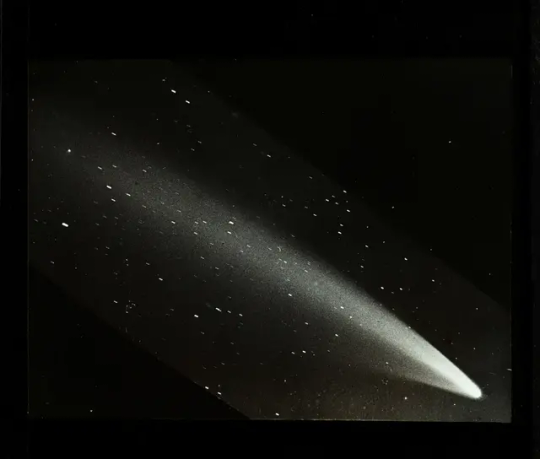
Glass plate slide of the comet of January 1910 from Lowell Observatory
#Great January Comet of 1910#astrophotography#astronomy#space#comet#Daylight Comet#Lowell Observatory#C/1910 A1#glass plate slide#science
816 notes
·
View notes
Text
The Great January Comet of 1910 aka The Daylight Comet aka Halley's Comet

Portents of death and destruction. Gouache, ca. 1910
Wellcome
12 notes
·
View notes
Photo

Comets
A comet is an icy small Solar System body that, when passing close to the Sun, warms and begins to release gases, a process called outgassing. This produces a visible atmosphere or coma, and sometimes also a tail. These phenomena are due to the effects of solar radiation and the solar wind acting upon the nucleus of the comet. Comet nuclei range from a few hundred metres to tens of kilometres across and are composed of loose collections of ice, dust, and small rocky particles. The coma may be up to 15 times the Earth's diameter, while the tail may stretch one astronomical unit.

If sufficiently bright, a comet may be seen from the Earth without the aid of a telescope and may subtend an arc of 30° (60 Moons) across the sky. Comets have been observed and recorded since ancient times by many cultures.

Comets usually have highly eccentric elliptical orbits, and they have a wide range of orbital periods, ranging from several years to potentially several millions of years. Short-period comets originate in the Kuiper belt or its associated scattered disc, which lie beyond the orbit of Neptune.
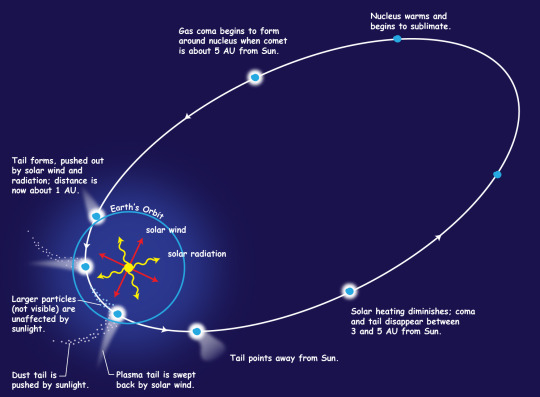
Long-period comets are thought to originate in the Oort cloud, a spherical cloud of icy bodies extending from outside the Kuiper belt to halfway to the nearest star. Long-period comets are set in motion towards the Sun from the Oort cloud by gravitational perturbations caused by passing stars and the galactic tide. Hyperbolic comets may pass once through the inner Solar System before being flung to interstellar space. The appearance of a comet is called an apparition.
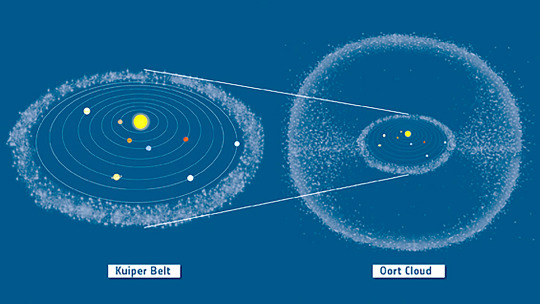
Comets are distinguished from asteroids by the presence of an extended, gravitationally unbound atmosphere surrounding their central nucleus. This atmosphere has parts termed the coma (the central part immediately surrounding the nucleus) and the tail (a typically linear section consisting of dust or gas blown out from the coma by the Sun's light pressure or outstreaming solar wind plasma). However, extinct comets that have passed close to the Sun many times have lost nearly all of their volatile ices and dust and may come to resemble small asteroids. Asteroids are thought to have a different origin from comets, having formed inside the orbit of Jupiter rather than in the outer Solar System. The discovery of main-belt comets and active centaur minor planets has blurred the distinction between asteroids and comets.
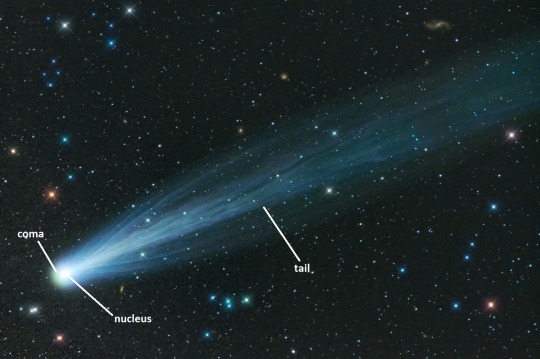
Exocomets
Exocomets beyond the Solar System have also been detected and may be common in the Milky Way. The first exocomet system detected was around Beta Pictoris, a very young A-type main-sequence star, in 1987.A total of 10 such exocomet systems have been identified as of 2013, using the absorption spectrum caused by the large clouds of gas emitted by comets when passing close to their star.
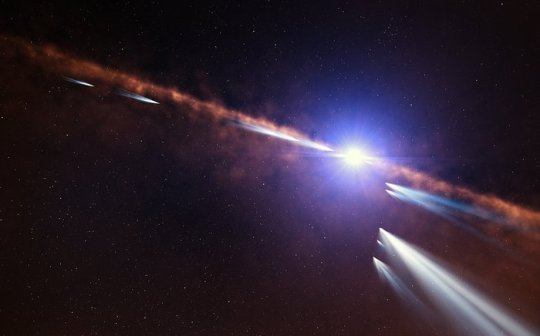
Connection to meteor showers
As a result of outgassing, comets leave in their wake a trail of solid debris too large to be swept away by radiation pressure and the solar wind. If the Earth's orbit sends it though that debris, there are likely to be meteor showers as Earth passes through. The Perseid meteor shower, for example, occurs every year between 9 and 13 August, when Earth passes through the orbit of Comet Swift–Tuttle. Halley's Comet is the source of the Orionid shower in October

Comets and impact on life
Many comets and asteroids collided with Earth in its early stages. Many scientists think that comets bombarding the young Earth about 4 billion years ago brought the vast quantities of water that now fill the Earth's oceans, or at least a significant portion of it. Others have cast doubt on this idea. The detection of organic molecules, including polycyclic aromatic hydrocarbons, in significant quantities in comets has led to speculation that comets or meteorites may have brought the precursors of life—or even life itself—to Earth.

Breakup and collisions
The nucleus of some comets may be fragile, a conclusion supported by the observation of comets splitting apart. A significant cometary disruption was that of Comet Shoemaker–Levy 9, which was discovered in 1993. A close encounter in July 1992 had broken it into pieces, and over a period of six days in July 1994, these pieces fell into Jupiter's atmosphere—the first time astronomers had observed a collision between two objects in the Solar System. Other splitting comets include 3D/Biela in 1846 and 73P/Schwassmann–Wachmann from 1995 to 2006. Greek historian Ephorus reported that a comet split apart as far back as the winter of 372–373 BC. Comets are suspected of splitting due to thermal stress, internal gas pressure, or impact.

Nomenclature
The names given to comets have followed several different conventions over the past two centuries. Prior to the early 20th century, most comets were simply referred to by the year when they appeared, sometimes with additional adjectives for particularly bright comets; thus, the "Great Comet of 1680", the "Great Comet of 1882", and the "Great January Comet of 1910".

After Edmund Halley demonstrated that the comets of 1531, 1607, and 1682 were the same body and successfully predicted its return in 1759 by calculating its orbit, that comet became known as Halley's Comet. Similarly, the second and third known periodic comets, Encke's Comet and Biela's Comet,were named after the astronomers who calculated their orbits rather than their original discoverers. Later, periodic comets were usually named after their discoverers, but comets that had appeared only once continued to be referred to by the year of their appearance.
In the early 20th century, the convention of naming comets after their discoverers became common, and this remains so today. A comet can be named after its discoverers, or an instrument or program that helped to find it.
Source
Here is a summary of previous and planned missions to comets
Images: Simon Addis, ESA/Rosetta, ESO, NASA, ESA, Damian Peach, Angel Montana
Comet ISON approaching the Sun observed by the spacecraft STEREO. 20 to Nov. 25, 2013.
3K notes
·
View notes
Text
The Black Lone Ranger of Calizona
From Ulysses to Charlemagne to Austin, all three generations of the known Kingsley family have abided by the same code, but it's not a code any of them can claim to have authored.
Clayton Orestes Stryker was born a slave, and conscripted into the Confederate States Army, before he liberated himself and a white conscripted Confederate soldier, Sloane Halloway.
Both boys were barely on the eve of adulthood, but Sloane never forgot the courage or the conscience of the young Black man, a year younger than himself, who secured their freedom.
Even though Clayton never wore a uniform or fought in combat (no Black man ever did for the Confederacy), his warnings to his fellow slaves on which battlefields posed the greatest threats turned his initials into a nickname, as they suggested that "CO" Stryker would have been a superior commanding officer to almost all of the white men who were actually commissioned.
If he'd been born white, Stryker would have been recognized as a genius, and indeed, when he ventured west, he adopted the alias of "Professor Paracelsus of the Prairie" to pitch his various inventions and tonics, while almost accidentally winning the hearts of young women of assorted races, even as his ethics demanded he stand up for justice, in those corners of the new frontier where no one else would, earning him the more popular sobriquet of "The Savant Gunslinger."
Without realizing that the "Professor Paracelsus" who first appeared in 1870 was his Civil War liberator, Sloane Halloway adopted the alias of Mr. Mystery, a.k.a. the original "Mystery Man," in 1877, and just as Professor Paracelsus was officially inducted into the cryptic Esoterica in 1885, so too was that honor extended to Mr. Mystery in 1888, finally reuniting the Civil War comrades.
Both Stryker and Halloway disappeared in the wake of the Great Daylight Comet of January 1910, along with fellow Esoterica member Frau Reisende and the Skeleton Key, one of the Esoterica's foes, as well as a nameless Asian woman claiming (in American-accented English) to hail from the future, but the legacies of the original Mystery Man and the Savant Gunslinger extended into the present, as both the Esoterica and the Kingsleys adopted Stryker's code.
Always learn, and always use what you learn: • To make yourself and your world ever better. • To make right what's wrong, and help those who most need and deserve it. • To pass on what you've learned, and befriend those as alone as you. • To prevent harm, and promote the truth, as broadly as possible. • To give back the good fortune you've gotten. Because any good deed, and any good adventure, always starts with learning, and always requires sharing, and sacrifice, to be complete.
Although Clayton Orestes Stryker never found time to settle down and start a family of his own, rumors persisted that one of his dalliances had conceived a child without his knowledge, and a generation later, an orphaned offspring of this bloodline was allegedly left as a foundling to be raised in the mother’s ancestral village of Eseldorf, in the tiny European nation of Weihnachtsstein, but after Prof. Hermes Germain's Encyclopædia Esoterica posited that this “golden child” was named "Atreus Koenig," most scholars dismissed these tales as apocryphal.
And that's how the Black Lone Ranger set the moral code of the Star Prodigy of Apex City.
Your timeline:
1844: Birth of Sloane Halloway.
1845: Birth of Clayton Orestes (C.O.) Stryker, a.k.a. Professor Paracelsus of the Prairie, the Savant Gunslinger.
1861: Conscription of C.O. Stryker into the Confederate States Army.
1862: Conscription of Sloane Halloway into the Confederate States Army.
1863: Desertion of "CO" Stryker from the Confederate States Army. 1863: Desertion of Sloane Halloway from the Confederate States Army.
1870: Birth of Dr. Albert Atlas Fell, a.k.a. the Skeleton Key. 1870: Debut of Professor Paracelsus of the Prairie, a.k.a. the Savant Gunslinger.
1877: Debut of Mr. Mystery, a.k.a. the Mystery Man.
1885: Induction of Professor Paracelsus into the Esoterica.
1888: Induction of Mr. Mystery into the Esoterica.
1900: Debut of Dr. Albert Atlas Fell as the Skeleton Key.
1910: The Great Daylight Comet of January 1910. 1910: Disappearance of Sloane Halloway, a.k.a. Mr. Mystery. 1910: Disappearance of Clayton Orestes "CO" Stryker, a.k.a. the Savant Gunslinger. 1910: Disappearance of the Skeleton Key.
1912: Birth of Ulysses Kingsley (né Atreus "Atreyu" Koenig).
0 notes
Text
Writers of Literature

Oscar Fingal O'Flahertie Wills Wilde (16 October 1854 – 30 November 1900) was an Irish poet and playwright. After writing in different forms throughout the 1880s, he became one of London's most popular playwrights in the early 1890s. He is best remembered for his epigrams and plays, his novel The Picture of Dorian Gray, as well as the circumstances of his imprisonment and early death.
Wilde's parents were successful Anglo-Irish intellectuals in Dublin. Their son became fluent in French and German early in life. At university, Wilde read Greats; he proved himself to be an outstanding classicist, first at Dublin, then at Oxford. He became known for his involvement in the rising philosophy of aestheticism, led by two of his tutors, Walter Pater and John Ruskin. After university, Wilde moved to London into fashionable cultural and social circles.
As a spokesman for aestheticism, he tried his hand at various literary activities: he published a book of poems, lectured in the United States and Canada on the new "English Renaissance in Art", and then returned to London where he worked prolifically as a journalist. Known for his biting wit, flamboyant dress and glittering conversational skill, Wilde became one of the best-known personalities of his day. At the turn of the 1890s, he refined his ideas about the supremacy of art in a series of dialogues and essays, and incorporated themes of decadence, duplicity, and beauty into what would be his only novel, The Picture of Dorian Gray (1890). The opportunity to construct aesthetic details precisely, and combine them with larger social themes, drew Wilde to write drama. He wrote Salome (1891) in French while in Paris but it was refused a licence for England due to an absolute prohibition on the portrayal of Biblical subjects on the English stage. Unperturbed, Wilde produced four society comedies in the early 1890s, which made him one of the most successful playwrights of late-Victorian London.
At the height of his fame and success, while The Importance of Being Earnest (1895) was still being performed in London, Wilde had the Marquess of Queensberry prosecuted for criminal libel. The Marquess was the father of Wilde's lover, Lord Alfred Douglas. The libel trial unearthed evidence that caused Wilde to drop his charges and led to his own arrest and trial for gross indecency with men. After two more trials he was convicted and sentenced to two years' hard labour, the maximum penalty, and was jailed from 1895 to 1897. During his last year in prison, he wrote De Profundis (published posthumously in 1905), a long letter which discusses his spiritual journey through his trials, forming a dark counterpoint to his earlier philosophy of pleasure. Upon his release, he left immediately for France, never to return to Ireland or Britain. There he wrote his last work, The Ballad of Reading Gaol (1898), a long poem commemorating the harsh rhythms of prison life. He died destitute in Paris at the age of 46.

Eric Arthur Blair (25 June 1903 – 21 January 1950), better known by his pen name George Orwell, was an English novelist, essayist, journalist, and critic. His work is marked by lucid prose, awareness of social injustice, opposition to totalitarianism, and outspoken support of democratic socialism.
Orwell wrote literary criticism, poetry, fiction, and polemical journalism. He is best known for the allegorical novella Animal Farm (1945) and the dystopian novel Nineteen Eighty-Four (1949). His non-fiction works, including The Road to Wigan Pier (1937), documenting his experience of working class life in the north of England, and Homage to Catalonia (1938), an account of his experiences in the Spanish Civil War, are widely acclaimed, as are his essays on politics, literature, language, and culture. In 2008, The Times ranked him second on a list of "The 50 greatest British writers since 1945".
Orwell's work continues to influence popular and political culture, and the term Orwellian – descriptive of totalitarian or authoritarian social practices – has entered the language together with many of his neologisms, including Big Brother, Thought Police, Room 101, memory hole, newspeak, doublethink, proles, unperson, and thoughtcrime.
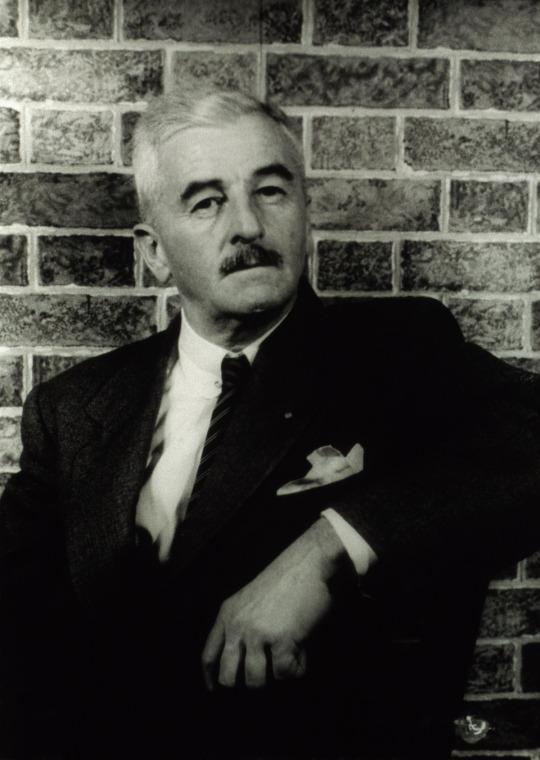
William Cuthbert Faulkner September 25, 1897 – July 6, 1962) was an American writer and Nobel Prizelaureate from Oxford, Mississippi. Faulkner wrote novels, short stories, a play, poetry, essays, and screenplays. He is primarily known for his novels and short stories set in the fictional Yoknapatawpha County, based on Lafayette County, Mississippi, where he spent most of his life.
Faulkner is one of the most celebrated writers in American literature generally and Southern literature specifically. Though his work was published as early as 1919, and largely during the 1920s and 1930s, Faulkner was not widely known until receiving the 1949 Nobel Prize in Literature, for which he became the only Mississippi-born Nobel winner. Two of his works, A Fable (1954) and his last novel The Reivers (1962), won the Pulitzer Prize for Fiction. In 1998, the Modern Library ranked his 1929 novel The Sound and the Fury sixth on its list of the 100 best English-language novels of the 20th century; also on the list were As I Lay Dying (1930) and Light in August (1932). Absalom, Absalom! (1936) appears on similar lists. His first published story, "A Rose for Emily", is one of the most famous an American has written.
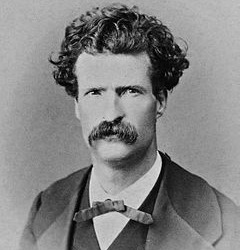
Samuel Langhorne Clemens (November 30, 1835 – April 21, 1910), better known by his pen name Mark Twain, was an American writer, humorist, entrepreneur, publisher, and lecturer. Among his novels are The Adventures of Tom Sawyer(1876) and its sequel, the Adventures of Huckleberry Finn (1885), the latter often called "The Great American Novel".
Twain was raised in Hannibal, Missouri, which later provided the setting for Tom Sawyer and Huckleberry Finn. He served an apprenticeship with a printer and then worked as a typesetter, contributing articles to the newspaper of his older brother Orion Clemens. He later became a riverboat pilot on the Mississippi River before heading west to join Orion in Nevada. He referred humorously to his lack of success at mining, turning to journalism for the Virginia City Territorial Enterprise. His humorous story, "The Celebrated Jumping Frog of Calaveras County", was published in 1865, based on a story that he heard at Angels Hotel in Angels Camp, California where he had spent some time as a miner. The short story brought international attention and was even translated into French.His wit and satire, in prose and in speech, earned praise from critics and peers, and he was a friend to presidents, artists, industrialists, and European royalty.
Twain earned a great deal of money from his writings and lectures, but he invested in ventures that lost most of it—notably the Paige Compositor, a mechanical typesetter that failed because of its complexity and imprecision. He filed for bankruptcy in the wake of these financial setbacks, but he eventually overcame his financial troubles with the help of Henry Huttleston Rogers. He chose to pay all his pre-bankruptcy creditors in full, even after he had no legal responsibility to do so.
Twain was born shortly after an appearance of Halley's Comet, and he predicted that he would "go out with it" as well; he died the day after the comet returned. He was lauded as the "greatest humorist this country has produced",and William Faulkner called him "the father of American literature".
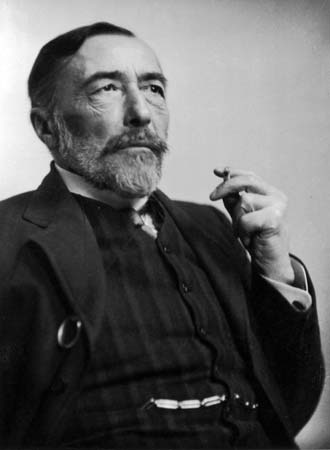
Joseph Conrad Józef Teodor Konrad Korzeniowski; 3 December 1857 – 3 August 1924) was a Polish-British writer regarded as one of the greatest novelists to write in the English language. He joined the British merchant marine in 1878, and was granted British citizenship in 1886. Though he did not speak English fluently until his twenties, he was a master prose stylist who brought a non-English sensibility into English literature.He wrote stories and novels, many with a nautical setting, that depict trials of the human spirit in the midst of an impassive, inscrutable universe.
Conrad is considered an early modernist, though his works still contain elements of 19th-century realism.His narrative style and anti-heroic characters have influenced numerous authors, and many films have been adapted from, or inspired by, his works.
Writing in the heyday of the British Empire, Conrad drew on, among other things, his native Poland's national experiences and his own experiences in the French and British merchant navies, to create short stories and novels that reflect aspects of a European-dominated world —including imperialism and colonialism —and that profoundly explore the human psyche. @maamdoralakwatsera
2 notes
·
View notes
Text
Doomsday Bunkers, Gas Masks, and Toilet Paper
Maggie Van (72549331) and Eric Vo (66458368)
When the world found out that the Mayan calendar ended on December 21, 2012, popular culture predicted that life as we know it would cease to exist. There were also numerous instances in history where people thought the world was going to end: Y2K during the year 2000, the Cuban Missile Crisis in 1962, the passing of Halley’s Comet in 1910, and the list goes on. The uncertainty of a catastrophic world-ending event has existed for ages, and with the current political, environmental, and social climate, many have taken preparedness into their own hands. On September 5, 2018, Bloomberg New’s Olivia Carville reported that the Silicon Valley elites’ preparations for the apocalypse include a detailed contingency plan. At the first sign of impending doom, executives plan to promptly exit the U.S to where their luxury bomb shelter awaits, buried deep in the soils of New Zealand.


Source: https://www.bloomberg.com/features/2018-rich-new-zealand-doomsday-preppers/
While some believe that stories like this may just be casual dinner talks over steak and wine, the current pandemic has proven that there are indeed some truths to these sensational headlines. News of the coronavirus outbreak (COVID-19) emerged from Wuhan, China during late December 2019 and quickly began to unravel into a citywide lock-down on January 23, 2020. Despite honest efforts to contain the disease, the coronavirus has now been deemed a pandemic by the WHO, affecting the United States, Italy, South Korea, Japan, and numerous other countries. As of March 12, 2020, there are over 134,000+ confirmed cases and 4,972 deaths worldwide. While some believe that this outbreak is not serious, others are preparing for the unpredictable nature of this virus. The contingency plans of Silicon Valley elites are eerily similar to the cases reported by The Guardian that the wealthy are boarding their private jets to flee from citywide quarantines to holiday homes in other countries to escape the virus, bringing along with them personal doctors and nurses in case that their families become infected.

Source: https://www.theguardian.com/world/2020/mar/11/disease-dodging-worried-wealthy-jet-off-to-disaster-bunkers
People who cannot afford these luxuries are taking a different approach to emergency preparedness. As the news began to report that cases are appearing in their countries, people have began hoarding goods in the event that they cannot leave their homes. In Orange County alone, Clorox wipes, toilet paper, masks, gloves, hand sanitizer, and bottled water began flying off the shelves at neighborhood stores such as Target, Walmart, and Costco.

In Figure 1, we illustrated that the fear of toilet paper shortage and lack of drinkable water during a possible countrywide quarantine has increased the demand for these goods as the demand curve shifts from D1 to the right to D2, raising the equilibrium price and quantity. (We did combine the graph for all these goods but it should be read that the graph is an illustration of what is happening to each individual goods since we did not want to create two identical graphs.) At Costco, we began seeing people hoarding toilet paper and water bottles causing supply shortage to the point that there is little to no supply of these goods. The increase in demand has led to shortages and caused Costco and other stores to implement policies to limit the amount of goods that each consumer can purchase.



As supplies of Clorox wipes and hand sanitizers began to dwindle, Clorox and Purell are preparing to combat the shortage by investing in more workers and resources to produce enough supply to meet high demands. In Figure 2, we illustrated this by shifting the supply curve from S1 to S2 to the right, increasing the equilibrium quantity and decreasing the equilibrium price. (We did combine the graph for all these goods but it should be read that the graph is an illustration of what is happening to each individual goods.)

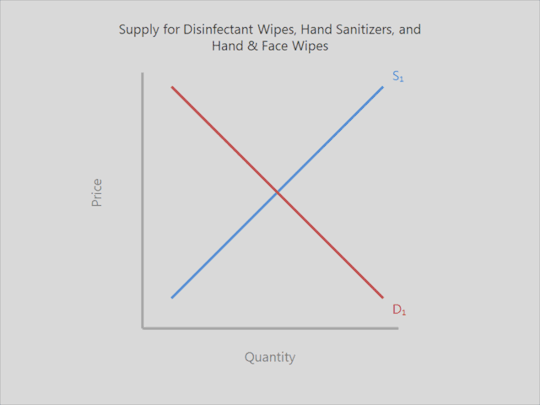
On the other hand, some eager suppliers are beginning to price gouge on essentials such as disinfectant wipes, hand sanitizers, and hand & face wipes since supplies are running low. Life-saving masks are also seeing the effects of price gouging. The problem is rampant in e-commerce that many groups are calling for government intervention from Attorney General Barr to combat the issue. Instead of waiting on government legislation, Amazon, a private company, is actively removing and punishing price gouging on its own platform.


The coronavirus outbreak continues to unravel in the United States and in many other continents as we continue to witness an increase in cases each day. We are in no way criticizing people for stocking up on essentials during these trying times. It is not a big issue to buy some extras on essentials and we think it is a smart thing to do. However, hoarding and price gouging are two issues that must be addressed through government regulations or private means and we can see that the government and private companies are actively trying to combat these issues as the situation progresses. We hope that the situation will be resolved soon and that our peers and the surrounding communities will pull through. In the meantime, wash your hands and be safe!
Bonus: Recently, electronic brand Xiaomi provided medical aid to Italy to help alleviate medical equipment shortages. It is great to see the world coming together to combat the virus even though there are numerous supply chain disruptions!

0 notes
Text
There’s Another Apocalypse This Month
It is with great sadness that we inform you- is again- it’s the end of the world soon.
The British tabloids and Fox News have been running floors this week about a conspiracy theoretician who has predicted that an cataclysmic rapture will begin on April 23, 2018. Pencil that date into your diary now in case you forget.
According to this chap, Planet Earth is fated because “on April 23, the Sun and Moon will be in Virgo, as will Jupiter, which represents the Messiah.” When this year appears, a planetary system known as “Planet X” or “Nibiru” will appear in the sky. By October, the crook planet will pass Earth and- BOOM- it will trigger a series of world-wide volcanic eruptions “due to its gravitational force”.
So, should you stock up on non-perishable goods, board up your spaces, and start repenting all your Earthly guilts? No , not unless that’s frequently how you invest your weekends.
In September 2017, there was a load of claims that “Nibiru” was coming to swallow up our little planet. NASA came so sick of this mass-circulating pseudoscience, they secreted a public statement about the claims to allay frights. In summing-up, they said the whole idea is a big misinterpretation of Mayan mythology and planetary science.
“If Nibiru or Planet X were real and headed for an encounter with the Land in 2012, astronomers would have been tracking it for at least the past few decades, and it would be visible by now to the naked nose, ” NASA patently explained.
“Obviously, it does not exist.”
Funnily enough, these alleges in September 2017 were started by the same person shaping these brand-new argues, a self-proclaimed “Christian Numerologist” who self-publishes records about scheme hypothesis under a pen name, David Meade. He started quite a stir last year with his Nibiru prophecies, much to the hassle of countless scientists. Christian Today, a Christian word firm, too seemed reasonably fed up with his antics, writing in September 2017 : “It’s moving Christians glance silly. Again … There is no such happening as a Christian numerologist.”
Meade’s track history might not be too hot, but just in case you’re still a little apprehensive about the impending rapture, here’s a short- by no means exhaustive- list of other recent doomsday projections that you have managed to survive:
When CERN started testing their Big Hadron Collider in 2008, many were persuaded it would create Earth-swallowing black holes.
People foresaw an apocalyptic contest on December 21, 2012, because this was believed to be the end-date of a 5,126 -year-long cycle in the Mesoamerican Long Count calendar.
In 1910, Halley’s comet was supposed to poison countries around the world.
Aum Shinrikyo, a Japanese sect held liable for a terrorist attack on the Tokyo subway in 1995, said the world would intention in 1996 or between 1999 and 2003 following a Third World War.
Media mogul and TV-evangelist Pat Robertson told his audience: “I guarantee you by the end of 1982 there is going to be a judgment on the world.” After his prediction descended flat, he then said it are more likely to happen on April 29, 2007.
During the Y2K bug scare, beings mulled world computer network would crash when the clocks altered from December 31, 1999, to January 1, 2000, sending “the worlds” into chaos.
0 notes